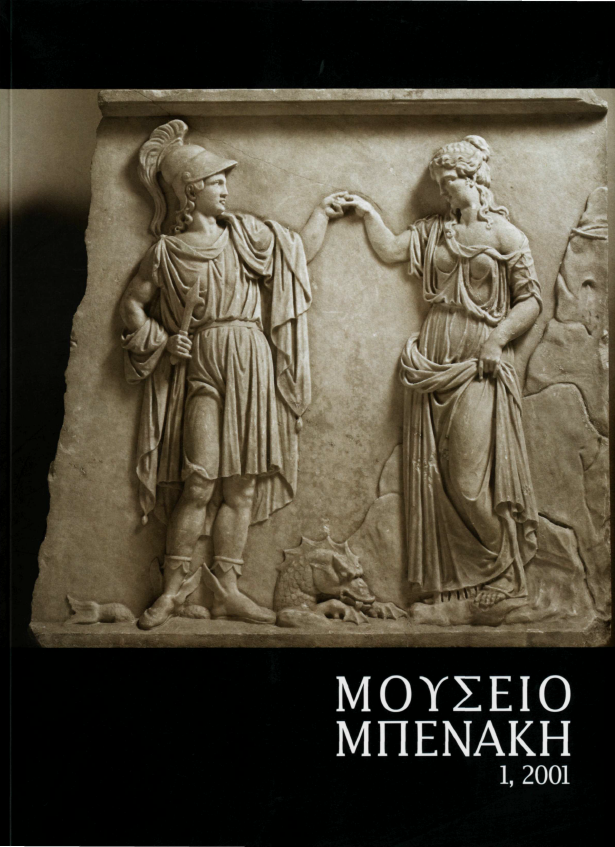The votive stele to Ennodia Koroutarra. A contribution to the study of the Thessalian goddess Ennodia or Pheraia
Abstract
In recent years new epigraphic evidence has been discovered which provides us with further information about the goddess Ennodia or Pheraea, the archetypal Thessalian deity, who was the object of special devotion in Thessaly and Macedonia and who had her origin in an Aeolian potnia. One of these items is the marble votive stele to Ennodia Koroutarra in the Benaki Museum. The stele dates from around the middle of the 4th c. BC and probably comes from Thessaly. The name and appellation of the goddess are written in dialect. The appellation Koroutarra (the dialect form of Korotarsa), found for the first time in connection with the cult of Ennodia, has its roots in the nouns κόρος and ταρσός-ταρρός (<ταρσόω-ταρρόω). The upright posture and gait of humans is known to depend on the tarsus (the tarsal bones, which extend between the toes and the ankle), and we are thus dealing with a goddess who helps children to rise to their feet, stand straight and walk. Ennodia Koroutarra is a goddess corresponding to Artemis Throsia, who "brings to safety" or "raises up the offspring". The appellation refers to the goddess's qualities of nurturing, loving and protecting children, which are confirmed by her other appellations astiki, storgikipatroa, stathmia, alexeatida, as well as korillos, which is found in Pherae itself. The epigraphic evidence available to us shows that Ennodia had many specialised attributes, as both the literary sources and her eleven known appellations make clear. The etymology of her name is illuminating both for tracing the origin of her cult and for understanding her original attributes. The main, primary functions of the goddess are indicated by the location of the shrine where her cult originated. The ancient cradle of her cult was outside the walls, next to the road leading from the north gate of Pherae to Larisa. Her shrine was founded within the proto-geometric cemetery and on the edge of the northern cemetery of the historical city. Ennodia was originally a goddess of the Underworld, death and highways, but as early as the 5th c. BC she had become an official, popular deity of the cities of Thessaly, and her powers covered a wide spectrum of human needs. The primeval local goddess had spread beyond Pherae and Thessaly before the classical period. The basic reasons for the dissemination of her cult were the richness of its content, its close connection with life, death, purification, highways, crossroads, gates and entrances, the warmth of its association with women, children and virgins, the convenient geographical location of the centre of her cult, the considerable power of Pherae from archaic times, and the festivals in her great shrine which were famous throughout Greece.
Article Details
- How to Cite
-
Χρυσοστόμου Π. (2018). The votive stele to Ennodia Koroutarra. A contribution to the study of the Thessalian goddess Ennodia or Pheraia. Mouseio Benaki Journal, 1, 11–20. https://doi.org/10.12681/benaki.18318
- Issue
- Vol. 1 (2001)
- Section
- Articles

This work is licensed under a Creative Commons Attribution-NonCommercial-ShareAlike 4.0 International License.
The copyright for articles published in Mouseio Benaki is retained by the author(s), with first publication rights granted to the journal. By virtue of their appearance in this open access journal, articles may be used freely for non-commercial uses, with the exception of the non-granted right to make derivative works, with proper reference to the author(s) and its first publication. The Benaki Museum retains the right to publish, reproduce, publicly display, distribute, and use articles published in Mouseio Benaki in any and all formats and media, either separately or as part of collective works, worldwide and for the full term of copyright. This includes, but is not limited to, the right to publish articles in an issue of Mouseio Benaki, copy and distribute individual reprints of the articles, authorize reproduction of articles in their entirety in another publication of the Benaki Museum, as well as authorize reproduction and distribution of articles or abstracts thereof by means of computerized retrieval systems.


